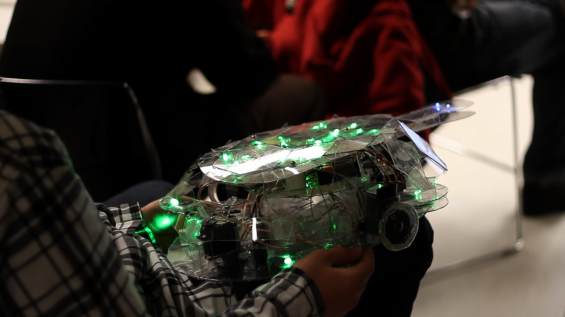
Design-Build Team: Kayla Guzovsky, Valerian Planche, Anthony Richardson, and Jay Rodman This project was presented as an opportunity to use the Arduino programming systems to make a dancing robot. My group agreed upon a Turtle as the character for our robot. At first, we had very imaginative ideas that included the turtle having a grappling head to help it climb walls, the ability to do acrobatic stunts, have lasers for eyes, and dance to music that it would play from speakers attached to its shell. Part of our project's description was to have our robot be interactive. For this part of the project we imagined the turtle being able to react to having music play, people's touch, and its orientation (being upside-down or right-side-up). We were planning on making a very realistic replica of a sea turtle for our general model that would move around on wheels. In reality our turtle moved its arms and legs in and out to execute dance moves while also shaking/wagging its head and tail back and forth. We wanted it to be a happy, friendly turtle. Its motions would work to express these characteristics. The turtle was made out of clear polycarbonate plastic. We used the foam prototype shell we constructed as a mold to place hexagonal and diamond shaped plastic cut outs to make the outer shell of the turtle. This plastic was used for the base, the four legs, the head, and the tail. To give the turtle motion we attached each limb to its own servo motor to allow each one to be retracted and pushed out individually. This required programming the proper angles using the Arduino so that the limbs pushed all the way out and pulled all the way in, but did not exceed the space limitations. All the motherboards were placed within the shell so space was an issue that we had to be conscious of while designing all the moving parts. All of this was powered by an external power system so that we did not need the turtle to remain attached to the computer. This was not the same for the dozens of LED lights that we attached in the limbs, shell, and eyes of the turtle; a battery powered these lights. For our group, timing was our biggest problem. We spent too much time making a prototype that never actually worked before starting on the final project. By Kayla Guzovsky
:rotate(0)/p39f1jed4mgd288myquiu5yecweg)